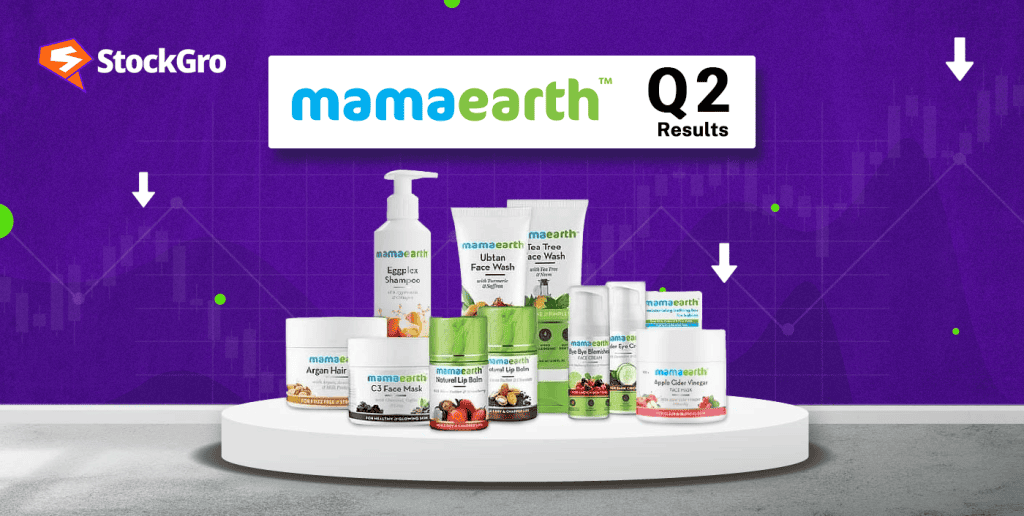
Introduction
Honasa Consumer Ltd., the parent company of Mamaearth, recently saw its shares plummet after a disappointing Q2 performance, falling over 18% and reaching a 52-week low of ₹242.60. For millennials and Gen Z investors, this stock slide highlights the impact of underwhelming earnings, shifting market strategies, and the realigned focus needed to maintain growth momentum in today’s competitive landscape. This article dives into Honasa’s Q2 financials, explores the reasons behind the decline, and assesses what the future may hold for Mamaearth shares.
Also Read: Beauty and the e-commerce beast: The Nykaa vs. Mamaearth showdown
Honasa’s Q2 Performance: A snapshot
The Q2 FY25 results delivered a wake-up call to investors, revealing Honasa’s first net loss in five quarters. Here’s a summary of the key financial takeaways from the report:
| Metric | Q2 FY25 | Q2 FY24 | Change |
| Consolidated Net Loss | ₹18.57 crore | ₹29.43 crore (Profit) | Negative |
| Revenue from Operations | ₹462 crore | ₹496 crore | -7% YoY |
| Total Expenses | ₹506 crore | ₹463 crore | – |
| EBITDA Margin | 6.60% | — | Down |
| Market Capitalisation Decline | Below $1 billion | — | Significant |
The disappointing numbers were attributed to inventory corrections and higher costs associated with Honasa’s shift to a direct-to-consumer (D2C) model, called Project Neev. This realignment is aimed at enhancing distribution efficiency, but in the short term, it has weighed heavily on revenue and profits.
You may also read: Zee Entertainment shares surge after Punit Goenka resigns
Market Reaction: How did Honasa shares respond?
Following the release of its Q2 earnings, Honasa Consumer’s share price tumbled, locking in a 20% drop on Monday and extending losses to an 18% decline on Tuesday, bringing the two-day loss to 35%. By mid-November, Honasa’s shares had plunged 53% from their 52-week high, erasing over ₹415 million in market value. This massive devaluation highlights investor concerns about the company’s growth trajectory, particularly in light of increasing competition and strategic shifts.
This shift in recommendations reflects the contrasting outlooks among analysts, with some seeing recovery potential and others advising caution as the stock undergoes volatility.
Why are Honasa Consumer shares dropping?
1. Profitability and Expense Challenges
One of the primary factors in Honasa’s underperformance was a rise in total expenses, up 9% year-on-year to ₹506 crore, which outpaced revenue growth. High operational costs, inventory adjustments, and strategic investments in Project Neev have placed additional strain on the company’s profitability.
2. Revenue Decline
For Q2 FY25, Honasa reported revenue of ₹462 crore, a 7% decline from the ₹496 crore it posted in Q2 FY24. While adjusted revenue (accounting for inventory corrections) came to ₹525 crore, showing a slight growth, the overall figures fell short of analyst expectations and contributed to the stock’s decline.
3. Shift to a D2C Model Under Project Neev
Honasa’s strategic shift to a D2C distribution model has impacted its top-line figures and caused disruptions in the short term. The move from super-stockists to direct distributors is aimed at better control over inventory and optimised distribution, but the immediate challenges of this transition have raised investor concerns about near-term growth.
4. Inventory Adjustment
The company reported that its lower-than-expected revenue was partly due to a one-time inventory correction aimed at recalibrating its supply chain. While this move is expected to bring long-term benefits, it has temporarily dampened the financial outlook for FY25.
You may also like: Tata Electronics Acquires Majority Stake in Tamil Nadu iPhone Factory
What does this mean for Mamaearth shareholders?
For investors holding Mamaearth shares through Honasa Consumer, the recent performance is a mixed signal. The long-term strategic shifts in the business model are aimed at better market positioning, yet the short-term financial impact has led to uncertainty in Honasa’s near-term stock potential.
- Short-Term Volatility: Shareholders should be prepared for continued stock price fluctuations as Honasa implements its distribution changes.
- Long-Term Potential: Project Neev, along with efforts to expand into offline channels, could improve market positioning over the long run. However, consistent revenue growth will be key to regaining investor confidence.
- Growth in Younger Brands: Honasa’s newer brands, including The Derma Co., Aqualogica, and Dr. Sheth’s, are gaining traction, contributing to 35% of total revenue with around 30% growth. This trend suggests diversification within the Honasa portfolio, which may help balance performance across different brands.
Future Outlook: Can Honasa rebound?
Honasa’s immediate outlook is challenging, with analysts generally predicting a gradual recovery over the next few quarters as the D2C model stabilises and Project Neev progresses. Here are some potential paths forward:
- Increase Profit Margins: Honasa may focus on reducing operational costs while seeking new ways to grow revenue. Optimising the D2C model could be a crucial factor in enhancing profitability.
- Leverage High-Growth Product Categories: Honasa’s newer brands, such as The Derma Co. and Dr. Sheth’s, are showing promising growth. By focusing on high-demand categories, like face washes and sunscreens, Honasa may increase its market share in key segments.
- Enhanced Market Positioning: Honasa’s pivot to D2C and its strengthened offline distribution strategy aim to establish Mamaearth and other brands as major players in personal care. While this may take several quarters to fully implement, the company’s long-term vision could set it up for renewed growth.
Conclusion
Honasa Consumer’s Q2 performance highlights both the challenges and opportunities the company faces as it navigates the competitive personal care industry. With shares falling by 18% in just two trading days and a series of downgrades from analysts, the road ahead is uncertain for Mamaearth’s parent company. However, if Honasa can effectively manage its distribution transition, control costs, and focus on high-growth categories, there remains potential for recovery.
Key Takeaway:
Honasa’s Q2 results have led to a dramatic stock drop, but the company’s commitment to strategic shifts and new growth avenues could help it bounce back in the long run.
FAQs about Honasa Consumer and Mamaearth shares
Q: Why did Honasa Consumer shares drop so sharply?
The shares fell due to weak Q2 results, widening losses, and concerns about the company’s valuation.
Q: How has the stock performed since its IPO?
Honasa Consumer shares have halved from their peak valuation, underperforming compared to market expectations.
Q: What should investors watch out for?
Investors should keep an eye on profitability improvements, demand recovery, and management’s future strategies.

